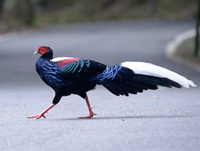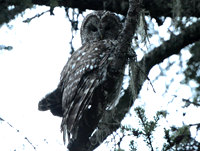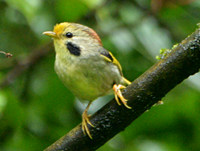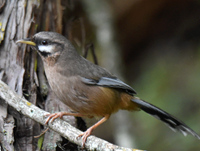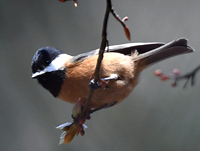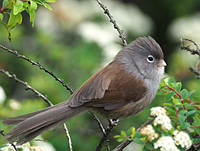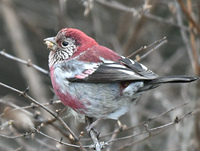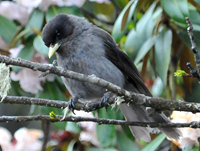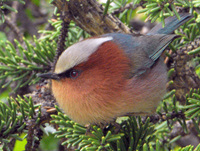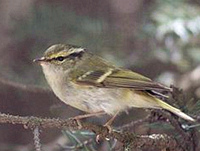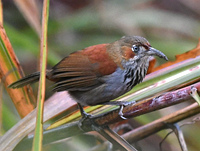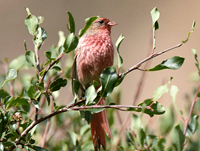Brief of the Endemic Birds in China

Summary
Located in the northern hemisphere, and the east of Asia which is the world's largest continent, China enjoys an excellent geological location with vast marine and land territories. To the east of the Chinese mainland is the world's largest ocean-Pacific Ocean. Covering an area of 9.6 million square kilometers in the land territory and 4.7 million square kilometers in the marine territory, China ranks the third in terms of the territory size in the world, only next to Russia and Canada. The vast land territory of China spans 5500 kilometers from south to north and 5200 kilometers from east to west with an elevation gap of 9000 meters. The vast land territory and huge distance traversing the territory have blessed China with almost all kinds of landform including mountains, plateaus, hills, basins, plains and deserts. From them, a great variety of habitats come into being such as oceans, wetlands, grasslands, forests, shrubs, deserts, and alpine screes.
The vast territory and diverse habitats make China one of the countries in the world enjoy the most diverse and abundant bird species. According to A Checklist on the Classification and Distribution of the Birds of China (The Third Edition) by Zheng Guangmei published in 2017, there are 1445 species of birds recorded in China, accounting for about 1/7 of the total bird species in the world and ranking among top 10 countries in terms of recorded bird species. Among them, 93 species are endemic birds of China.
An endemic species refers to the species whose distribution is limited to a special geographical area or a continent, but not in other places due to historical, ecological or physiological factors. Endemic species are usually found in isolated geographically areas, such as islands and plateaus. The main reason that explains the formation of an endemic species is that one group of species lost mating opportunities with the same species outside the group due to a certain degree of isolation from geographical separation or other factors. So the originally same species in different groups took different evolution routes respectively and eventually became two separate species.
In Hainan and Taiwan, the two big islands in the coastal southeast China, and in the isolated areas formed in Qinghai-Tibet Plateau and Himalayan Mountains, due to the isolation effects, many resident birds took separate involution routes and contributed to the abundant endemic species in China. Geographically speaking, there are 25 endemic species in Taiwan Island, 4 in Hainan Island, and 64 in the Chinese Mainland. While looking from the perspective of orders and families, the endemic species are dominated by Passeriformes with 65 species, followed by Galliformes with 22 species. The remaining three endemic species are found in Strigiformes, Caprimulgiformes, and Piciformes with one species for each order respectively. Under Passeriformes, endemic species are mainly found in families like Paridae, Leiothrichidae, Sylviidae, and Fringillidae with 5 or more endemic species for each family. The 22 endemic species under Galliformes are all from family Phasianidae.
Phasianidae
Of the world’s 180 Phasianidae species in total, China has 64 species in family Phasianidae, accounting for 35.5 % of the world total. Among them, 22 species are China endemics, taking up 34.3% of the total Phasianidae species in China. In addition, Tetraophasis and Crossoptilon are only found in China. So we can boldly conclude that China is the distribution center of family Phasianidae in the world. There are two endemic species under etraophasis, namely Chestnut-throated Monal Partridge(Verreaux's Partridge) and Buff-throated Monal Partridge(Szechenyi's Partridge), they are mainly found in high elevation areas in southwest China. There are 4 endemic species under Crossoptilon, the White Eared Pheasant, Blue Eared Pheasant, Tibetan Eared Pheasant are mainly found in Qinghai-Tibet Plateau and its surrounding areas in west China, while Brown Eared Pheasant is mainly distributed in areas close to Taihang Mountains in northern China. The rest of endemic species under family Phasianidae are distributed in different parts of China, Rusty-necklaced Partridge(Przevalski's Partridge) in rocky areas of grasslands in northwest China; Chinese Monal, Sichuan Partridge and Chinese Grouse in mountainous areas in southwestern China; Cabot’s Tragopan, White-necklaced Partridge and Elliot’s Pheasant in the hilly areas of south China; Reeve’s Pheasant is endemic to hilly areas in the central part of China; Chinese Bamboo Partridge is widely distributed in the southern part of China; In the forests of the mountainous areas in western China, Golden Pheasant can be found; in Taiwan Island, Swinhoe’s Pheasant, Taiwan Partridge, and Mikado Pheasant can be found; while in Hannan, Hainan Partridge and Hainan Peacock Pheasant can be found.
Of the world’s 180 Phasianidae species in total, China has 64 species in family Phasianidae, accounting for 35.5 % of the world total. Among them, 22 species are China endemics, taking up 34.3% of the total Phasianidae species in China. In addition, Tetraophasis and Crossoptilon are only found in China. So we can boldly conclude that China is the distribution center of family Phasianidae in the world. There are two endemic species under etraophasis, namely Chestnut-throated Monal Partridge(Verreaux's Partridge) and Buff-throated Monal Partridge(Szechenyi's Partridge), they are mainly found in high elevation areas in southwest China. There are 4 endemic species under Crossoptilon, the White Eared Pheasant, Blue Eared Pheasant, Tibetan Eared Pheasant are mainly found in Qinghai-Tibet Plateau and its surrounding areas in west China, while Brown Eared Pheasant is mainly distributed in areas close to Taihang Mountains in northern China. The rest of endemic species under family Phasianidae are distributed in different parts of China, Rusty-necklaced Partridge(Przevalski's Partridge) in rocky areas of grasslands in northwest China; Chinese Monal, Sichuan Partridge and Chinese Grouse in mountainous areas in southwestern China; Cabot’s Tragopan, White-necklaced Partridge and Elliot’s Pheasant in the hilly areas of south China; Reeve’s Pheasant is endemic to hilly areas in the central part of China; Chinese Bamboo Partridge is widely distributed in the southern part of China; In the forests of the mountainous areas in western China, Golden Pheasant can be found; in Taiwan Island, Swinhoe’s Pheasant, Taiwan Partridge, and Mikado Pheasant can be found; while in Hannan, Hainan Partridge and Hainan Peacock Pheasant can be found.
There are three endemic non-Passeriformes species coming from three different families respectively, namely Sichuan Wood Owl(Pere David's Owl) from family Strigidae of Strigiformes found in conifer forests of mountainous areas in southwest China; Vaurie’s Nightjar from family Caprimulgidae of Caprimulgiformes, a very mysterious but controversial bird found in the desert area of the Kunlun Mountains in northwest China, and Taiwan Barbet from family Megalaimide of Piciformes, only found in Taiwan Island.
Passeriformes
The endemic birds from Passeriformes have 65 species from 26 families. There are four families that each has five or more than five species of endemic birds with a combination of 37 species in total, accounting for 55.2% of the total number of endemic species under Passeriformes. Respectively, there are 19 species from family Leiothrichidae, 7 species from family Paridae, 6 species from family Sylviidae, and 5 species from family Fringillidae. The remaining 31 endemic species falling into 22 families, for instance, there are 4 species of Timaliidae, 3 species of Phylloscopidae, 3 species of Muscicapidae, and 1 species of Sittidae, etc.
Leiothrichidae
Of the world’s 146 bird species in family Leiothrichidae, China has at least 70 species, taking up almost half of the total species of Leithrichidae. Among them, 19 species are endemic to China, accounting for 27.1% of the total in family Leiothrichidae in China. They are Tibetan Babax, Snowy-cheeked Laughingthrush(Sukatschev's Laughingthrush), Barred Laughingthrush, White-speckled Laughingthrush (Biet's Laughingthrush), Giant Laughingthrush, Elliot’s Laughingthrush, Brown-cheeked Laughingthrush(Prince Henry's Laughingthrush) and Emei Shan Liocichla, mainly found in the mountainous areas in southwest China or Qinghai-Tibet Plateau and surrounding areas; Plain Laughingthrush(Pere David's Laughingthrush) found in the hilly areas of north China, Rufous Laughingthrush(Buffy Laughingthrush) found in the hilly areas of south China; the extremely endangered Blue-crowned Laughingthrush found in the hilly areas of central China, Hannan Hwamei which is only found in Hainan; some laughingthrushes only found in Taiwan including Taiwan Hwamei, Rufous-crowned Laughingthrush, Rusty Laughingthrush, White-whiskered Laughingthrush, Steere’s Liocichla, Taiwan Barwing, and White-eared Sibia.
Paridae
The 7 endemic species from family Paridae are Rusty-breasted Tit(Pere David's Tit), White-browed Tit and Sichuan Tit that mainly found in the mountainous areas in southwest China; Ground Tit found on Qinghai-Tibet Plateau, Yellow-bellied Tit which is widely found in south China, Chestnut-bellied Tit and Yellow Tit that are only found in Taiwan Island.
All the 6 endemic species from family Sylviidae are distributed in the mountainous areas in southwest China or Qinghai-Tibet Plateau and surrounding areas. They are Rufous-tailed Babbler, Chinese Fulvetta, Three-toed Parrotbill, Spectacled Parrotbill, Grey-hooded Parrotbill, and Rusty-throated Parrotbill(Przevalski's parrotbill).
Fringillidae
The 5 species from family Fringillidae are Sillem’s Mountain Finch(Sillem's Rosefinch), Chinese Beautiful Rosefinch, Tibetan Rosefinch, and Three-banded Rosefinch, which are found in the mountainous areas in southwest China or Qinghai-Tibet Plateau and surrounding areas, and Taiwan Rosefinch which is only found in Taiwan Island.
Corvidae
The 3 endemic species in family Corvidae are Sichuan Jay, which is narrowly distributed in the conifer forests in southwest China, Xinjiang Ground Jay found in the desert area in northwest China, and Taiwan Blue Magpie which is only found in Taiwan.
Aegithalidae
The 3 endemic species in family Aegithalidae are Silver-throated Bushtit in the mountainous areas in north China, Sooty Bushtit in the mountainous areas in central China, and Crested Tit Warbler in high-elevation areas in southwest China.
Phylloscopidae
The 3 endemic species in family Phylloscopidae are Gansu Leaf Warbler, which has narrow distribution in central China, Emei Leaf Warbler which is narrowly distributed in the mountainous areas in southwest China and Hainan Leaf Warbler, which is only found in Hainan Province.
The 4 endemic species from family Timaliidae include Grey-sided Scimitar Babbler distributed in the hilly areas in south China, Nonggang Babbler found in hilly south China, and Black-necklaced Scimitar Babbler and Taiwan Scimitar Babbler which are only distributed in Taiwan Island.
Other Families
The 1 species of endemic species in family Pellorneidae is Golden-fronted Fulvetta mainly found in the mountainous areas in southwest China. The 1 endemic species of family Sittidae is Yunnan Nuthatch found in the mountainous areas in southwest China. The 1 endemic species of family Certhiidae is Sichuan Treecreeper found in the mountainous areas in southwest China. The 2 endemic species of family Turdidae are Chinese Blackbird widely found in south China and Chinese Thrush mainly distributed in the mountainous areas in southwest China. The 3 species of family Muscicapidae are Ala Shan Redstart which mainly found in woody areas in north China, and Collared Bush Robin and Taiwan Whistling Thrush which are only found in Taiwan Island. The 1 endemic species of family Urocynchramidae is Pink-tailed Bunting (Przevalski's Pinktail), the only species in this family distributed mainly in the eastern edge of Qinghai-Tibet Plateau. The 2 endemic species of family Emberizidae are Slaty Bunting found in the forest area in south China and Tibet Bunting distributed on Qinghai-Tibet Plateau. The remaining 4 endemic species fall into four families namely Pycnonotidae, Pnoepygidae, Zosteropidae, and Regulidae with one for each family are only distributed in Taiwan Island. They are Styan’s Bulbul, Taiwan Cupwing, Taiwan Yuhina and Flamecrest.
Speaking from the composition of the abundant endemic bird species in China, they are mainly from families like Phasianidae, Leiothrichidae, Paridae, Fringillidae, and Sylviidae. Looking from their distribution, they are mainly found in the mountainous areas of Sichuan and Yunnan Provinces in southwest China, Qinghai Province and Tibet Autonomous Region on Qinghai-Tibet Plateau, the coastal areas in south China represented by Taiwan and Hainan islands, and the hilly areas in east China mainly represented by Jiangxi and Fujian Provinces.
